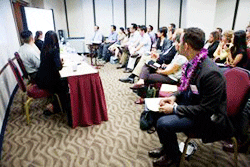
Photo credit: courtesy of National CAPACD
We’ve written about the tensions that can arise when community developers and organizers of different ages, genders, or ethnic and racial backgrounds work in the same spaces. National CAPACD enthusiastically embraced all of these issues at its convention last week, the theme of which was “Moving Forward, Rising Together: Uniting for Thriving Communities.”
It opened with a look back by several founding members, including Gordon Chin, founding executive director of the Chinatown CDC and author of the new book, Building Community, Chinatown Style, Bob Santos, leader, activist, and former director of InterimCDA (and co-author of the book Gang of Four) and Sue Taoka, executive V.P. of the CDFI Craft 3 (and former co-president of the National Coalition of Asian Pacific American Community), who said that “the founding of National CAPACD gave each of their groups a voice at the local, state, and national levels.”
A point of context, referred to more than once, was the I-Hotel. In the late ’60s and early ’70s, the uprising and protests at this San Francisco hotel by poor, Asian (predominantly Filipino) residents were catalyzing events that not only opened the city’s eyes to the devastating effect Urban Renewal was having on poor and disenfranchised communities, but hinted at the potential power organizing could have for Asian American and Pacific Islanders. The respect for this grassroots spirit was evident in the recognition of new and veteran members, and was reflected in its theme of “renewed focus on working in coalition with communities of color on issues of racial justice.”
The difficulty in relationship building between communities of color is well known (hence our need to highlight successful partnerships here), and a panel speaker noted that people who are struggling for survival are often told that their fight is with others who are struggling, when in reality they are each other’s best allies. Kabzuag Vaj touched briefly on her organization, Freedom Inc. in Dane County, Wisconsin, which was founded by Black and Hmong women to give a voice to low-and no-income residents, as an example of a successful, intentional partnership. And as LGBTQ issues come to the forefront of discussions surrounding access and equity, groups such as prYSM, 1Love, and Freedom Inc., were applauded for their work in ensuring that the realities of gender, sexual orientation, and ethnic and cultural diversity within AAPI community development work have representation at the table.
In an open and honest workshop on on multi-generational approaches in building community, it was surprising to hear some pushback against bringing old and young together. Sarath Suong of prYSM (Providence Youth Student Movement) considers their offices as “safe spaces” for young people often facing abuse and judgement at the hands of older family and community members, and having a divide gives them room to heal. He added that calling young people “leaders of tomorrow” (a phrase I think many of us rattle off, but with the best intentions) doesn’t recognize them for the work they do now.
In the same workshop, a speaker of Polynesian descent noted that her culture is matriarchal, and thus issues that some others have with regard to women begin ushered to stand behind men was not her experience. Its a topic that needs more exploration, and we’d love to have the discussion here.
As Americans of Asian descent continue to compose the largest-growing racial group in the country, poverty statistics expose the myth of the “model minority” as having undermined, and continuing to do great damage to, the cause of racial justice in the AAPI community. Native islanders, second and third generation Americans, and new immigrants experience many of the same discrimination they always have—we were reminded of American (and Canadian) Japanese interment camps after WWII, and how that tainted legacy seemed to do nothing to inform the behavior of police and investigative authorities after 9/11 in their treatment of many South Asian Americans.
ChangeLabs’ Soya Jung gave a stirring summary of the historical presence of Asian Americans in the Civil Rights movement on to the AAPI community’s support of today’s #BlackLivesMatter movement—a rejection of the nation’s system of racial supremacy and anti-blackness, and how that affects all disenfranchised communities. As both groups disproportionately face displacement due to gentrification and police violence and harassment, how they fare in the coming years will have great implications for the country as a whole.
In an announcement that couldn’t have been timed better, on Tuesday, the Department of the Interior announced its proposal of a path for reestablishing a government-to-government relationship with the native Hawaiian community. If such a relationship is reestablished, it can provide the native Hawaiian community greater ability to preserve its culture, as well as special status under federal law that would enable the community to exercise self-governance. This victory did not come without decades of relentless policy advocacy work, and included a year-long public meeting and comment period that elicited over 5,000 written responses.
National CAPACD’s 15th annual convention was jam-packed with challenging discourse, policy platform work, even a rally—all approached with positive energy. Here on Rooflines, we look forward to featuring the voices of many people and groups we met there in the coming months.






Comments